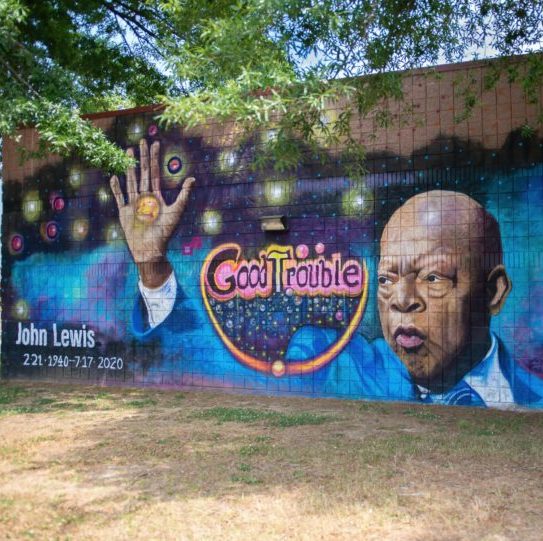EDITOR’S NOTE: This post introduces readers to a rhetorical re-framing of narrative nonfiction that a Vanderbilt University professor argues can create partnerships between writers and readers in pursuit of addressing societal problems. This week and next, we feature each of his seven approaches to story projects.
How do writers of narrative non-fiction tackle social problems? It’s easy enough to think that problems just float out there, awaiting journalists capable of finding and capturing them and wrestling them into words.
But writers actually take realities that readers might gloss over or write off, and then craft words that help people notice and interpret them as social problems that warrant thought and action. To take inspiration from the late civil rights leader and U.S. Congressman John Lewis, writers use language to make good trouble that needs to get made. To do this, writers almost always learn about the social problems from those who first brought them to light: the people directly affected by them or activists they work with, whose protests and voice — often against serious odds — punctured the silence, euphemism and complacency that shrouded the problem against critical inspection. They provide not only information about the problem, but ways to make sense of it.
So how do writers go about crafting an understanding of problems from this starting point? To answer this, it’s worth parsing two different meanings of the word “problem:”
- There is problem as something that you find upsetting or concerning — something that clashes with your sense of the way the world ought to be, is broken and needs to be repaired.
- And then there is problem in the sense of a math problem: a puzzle or conundrum that needs sustained thinking to make sense of, untangle and perhaps even solve.
Plenty of non-fiction writing about society confronts a problem in one of these two senses but not the other: texts that challenge a troubling social reality their authors think they have completely figured out; and texts that play with some intriguing, elusive mystery, the broader social stakes of which are unclear or unimportant to the writer.

The best narrative non-fiction writing on social problems does both. It grapples with a particular social reality in order to question it, subject it to critical attention and convince readers that its existence and continuance is not inevitable. Writing that does this communicates to readers that the problem is tricky, requiring the combined intelligence of author and reader. For this reason, however paradoxically, the best works of narrative non-fiction that deal with social issues may not start out with a firm sense of a known problem. Rather, they can set out to profile an intriguing setting or situation, for example, that has some disquieting aspects.
This approach has lots of advantages. It gives writers the room and time needed to figure out for themselves, ideally through close, sustained reporting, what the problem actually is rather than assuming they already know. As they work it out, they stay alive to details that have distant or ambiguous relationships to the problem, or maybe none at all. This tack makes it less likely that writers will reduce the people in question to individuals whose existence is completely enveloped by the problem. (Shrinking people down to the problems they confront can, of course, come dangerously close to defining the people themselves as the problem.)
Writers working in this exploratory mode also are more likely to remain open to investigating a problem’s many causal roots and manifestations, and to hearing from people who are actually experiencing it: how they define the situation, where they think it comes from, why it’s a problem for them and what they think should be done about it.
Perhaps most of all, this approach invites the reader in as an intellectual partner and companion. Problem-oriented writing can seem convinced of its moral superiority: The virtuous writer pronounces from on high, squinting hard enough that the choir they are preaching to blurs into an expansive, imaginary congregation. In contrast, writing that approaches social problems as intellectual problems says to readers: I’m bothered by this… Let’s dive in together.
Social-issues stories that reimagine society
Why is it so essential to investigate, present and wrestle with social problems in the first place? First, it’s crucial because it’s one way that society gets imagined and reimagined.
There are countless ways that we’re told that things we recognize as problems have nothing to do with the ways society is organized.
There are countless ways that we’re told that things we recognize as problems have nothing to do with the ways society is organized. We’re told that these problems are intractable — the result of individual failings, punishment by transcendent forces, fate or bad luck, or just the way the world works. Highly capitalist societies may be especially prone to underestimating and minimizing the social origins and character of problems, sidelining questions about whether social institutions need to be built differently. Think of how often we’re told that poor people could have simply bootstrapped themselves to prosperity, without any larger, systemic changes.
But one of the most compelling things that narrative nonfiction can do is to show how problems that seem individual, cosmological or matters of inescapable destiny are actually social and political problems, therefore rightly subject to public debate and collective, remedial action. As writers detail the social and changeable dimensions of a problem, they can enrich readers’ visions of society and their role in it.
Through the process of defining its problems, a community defines the common good and makes sense of its shared life together. Together, it frames the meanings of justice, freedom, equality, well-being and other values it decides are worth defending.
Articulating problems also can mean redrawing the very boundaries of the political “we.” The rhetorical choices a writer makes resonate with certain people — and not others — and summon them to participate in an implied “us.” These choices communicate who matters — whose freedom and domination, thriving and suffering counts — and, more fundamentally, the question of who has standing to join in debate and decision-making.
Through the process of defining its problems, a community defines the common good and makes sense of its shared life together.
While it’s a mistake to overestimate the power of any particular story, the best nonfiction writing about social issues can help assemble new communities, public spheres and spaces of deliberation. The choices a writer makes — about emphasis, framing, rhetoric, voice and societal purpose — can raise scaffolding for new architectures of “we.”
We’re constantly absorbing the objectionable into our everyday sense of the normal: Problems that were once overt and charged — that animated peoples’ sense of self and society — fade with time, political change and concerted efforts to bury them. Vast swaths of norms, hard-won rights and valid objections are perpetually at risk of being obscured and forgotten, as we gradually, without even noticing, accommodate to things that were previously unacceptable.
This capacity to normalize the bad is both adaptive and terrifying. But rather than seeing it as the cause for naive hope or hopeless despair, it can remind us of the need for vigilant, unyielding, inquiring attention to problems that threaten to vanish without going away. That can be, at its most valuable, the work of narrative nonfiction.
New frames for addressing societal problems
Whenever in the process of research and drafting that a writer settles on a sense of what the problem is, they need to think hard about the relationship between a desired audience with particular subjects and themes. Will readers see a problem here? If not, why not? And how could framing the situation in new terms, or providing new evidence, help them see differently? If readers already see the situation as a problem, are they inclined to approach it in ways that overlap with yours?
To get more concrete, let’s distinguish a variety of story approaches taken by non-fiction writing about society. I’ll consider seven of them in coming posts:
- Introduction: Making good trouble
- I. Exposure: Highlighting overlooked problems
- II. Urgency: Revealing the immediacy of problems
- III. Activation: Challenging a sense of powerlessness
- IV. Re-specification: Reconsidering causes and effects of a problem
- V. Solidarity: Standing with those affected
- VI. Responsibility: Connecting action to consequence
- VII. Value-switching: Considering different moral stances
- Conclusion: The gift of narrative nonfiction
Each of these frames a partnership between a writer and a reader as partners:
We’re in this together, they say, but we’re not the same. Maybe we share key values but don’t have the same information. Maybe we possess similar knowledge but prioritize issues in different ways. Our commonalties and differences will shape the terms of engagement between us and the worlds we are learning and thinking about together.
One of the most important decisions the writer makes here — one that will affect which tasks you take up and how — is how to position yourself. Do you adopt the stance of a detached observer, affected only as anyone else would be? Do you take on the perspective of insiders with direct experience and knowledge of the problem? Or do you write from the position of both outside expert and first-hand witness?
The writer’s stance: a crucial choice
A great deal hinges on this choice and the way you express it. Each position asserts a different kind of authority. Outsiders tend to advance claims of rationality, disinterestedness and fluency in multiple perspectives. Insiders convey truths that only victims and eyewitnesses can: unmediated experience, potent emotions and enduring consequences.
The position you assume as a writer can change the basic meanings of the seven story modes I sketch out. Imagine, for example, the vast difference between an outsider holding readers partly responsible for a problem, and that same charge arriving in the voice of an insider who tells you they have directly suffered it themselves.
These seven project categories are seldom isolated or confined, one at a time, in any single nonfiction narrative. They get stirred together, with each picking up and heightening the others. But it helps to grasp their purposes one by one. Skilled cooks already know just how much of each flavor to toss into a dish, and when, without studying the spice rack. But they can learn by lingering briefly over each, how it works and what it brings to the whole.
NEXT: Exposure: Stories that expose overlooked problems
***
Paul A. Kramer is an associate professor at Vanderbilt University, where he teaches history and non-fiction writing. He is the author of several academic studies and essays that have been published by major news sites. His book, “The Blood of Government,” has won several awards, including being named a finalist for the Philippines National Book Award in the social science category.



